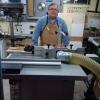
Originally Posted by
daniel lane

Nothing gory, fortunately.
My son and I built a little dump truck today - his first real project in the shop - and the last cut of the day resulted in kickback. [Clarification: I don't let him anywhere near the power tools, so he was never in any danger.] We were cutting up a 2x4 to glue and nail together, and he was having trouble with the coping saw. I figured it was kinda mean to have him clip 1/4" off each 2x4 edge by hand, anyway, so I turned to the table saw.
Now, I've read the stories on here, I've read the magazine articles, I've read the books, and I've watched the movies. I'm pretty paranoid and careful around the tablesaw, as I really didn't want to experience what I did today. And STILL I wound up with a block of wood to the chest. Luckily, it was soft pine (2x4) and only about the size of my fist, but as I pushed the block through (with a push stick, mind you), the block tilted ever so slightly left, got picked up, and WHAM...right into the left side of my chest. The blood was minimal, but you can see the end grain pattern in my skin, embossed through my t-shirt, and I've a welt that swollen at least 3/4". This small block - about the size of my fist - made me feel like I got kicked in the chest by a mule. And it's darn sure gonna leave a heck of a bruise. [It's wierd - I can feel the pain in my neck and jaw, it's radiating that wide.]
So......I figured I'd publicly shame myself as an object lesson and take the opportunity to remind people - be careful! Even though I know how it happens and was taking great care to avoid it, it still happened to me. And I figured there was no way - I was standing to the RIGHT of the blade, not even in line with it! Turns out, the block bounced off the inside of the push stick and barely missed my hand, the deflection angled it into my chest. See, I figured I'd be smart and push from the back and left to keep the piece close to the fence...and that is almost certainly what caused the front to angle into the blade. If I were to do it again, I'd make the cut on the bandsaw instead...but it isn't set up yet, so I was making the cut on the TS rather than lose an hour with the boy while I tinkered with it and dug through boxes to find the blades. (Let that be a lesson to me!)
Be safe, folks. And don't do what I did.
daniel





 Reply With Quote
Reply With Quote








